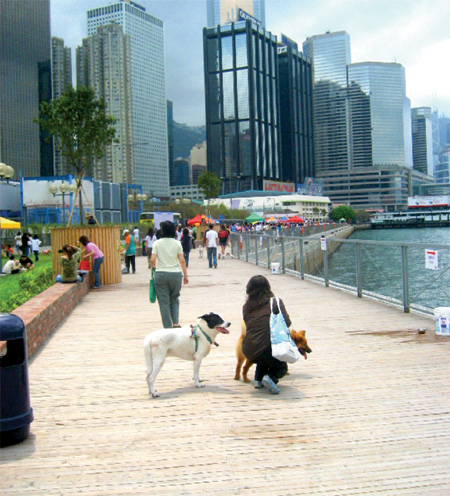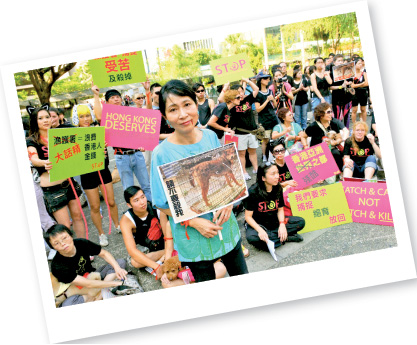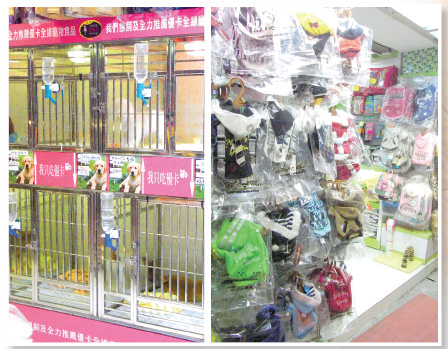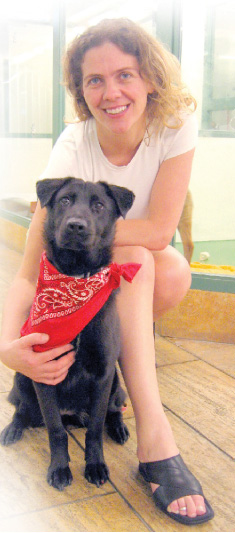A dog's life
Updated: 2010-12-17 08:02
By Daniel Pordes(HK Edition)
|
|||||||||
|
A demonstration by animal rights groups. Photos Provided to China Daily |

Hong Kong is making incremental steps toward the prevention of animal cruelty but animal welfare groups say even with more legislation and growing public awareness, the city lags far behind other cities in protecting animals. Daniel Pordes reports.
Among the dogs at the Hong Kong Dog Rescue center, Whizz, the 2-year-old Chihuahua mix can't help but stand out. Spinning like a whirling dervish, growling and snapping, he repeatedly attempts to grab his tail in a rotating frenzy. It seems cute at first, until you notice his tail is no longer there. It had become so mutilated that it had to be cut off.
"That's what happens when you cage a dog," says Norma Mitrovich, a volunteer at the center. "It makes them go stir-crazy."
Whizz was kept in a cage prior to being abandoned by his owners and was driven mad by the lack of space. His close confines forced him to go round and round in circles, chasing and biting incessantly at the tail until it had to be surgically removed. An anxious twitch that kicks in on occasion, Whizz's behavior now is actually far improved from when he was first brought to the center as a nervous wreck. Meanwhile, curled up asleep in a basket nearby, away from all the commotion, is Turbo, a Shih Tzu, almost completely blind and partially deaf. At 10 years old, he has been a long-term resident here, and it's likely that he will see out his days at the center.
Turbo and Whizz, and 16 other dogs fill the small two-story building in the southern district of Ap Lei Chau. Another 300 larger dogs reside in their kennels in Tai Po. All of these former pets were first abandoned to the government's animal management centers run by the Agriculture, Fisheries and Conservation Department (AFCD) by owners who decided they were too old, too boisterous, required too much work or simply went out of fashion.
These dogs actually are the lucky ones, taken in by the dog charity. According to government statistics, 90 percent - a total of around 44,000 - of the dogs taken in by the AFCD from 2006 to 2009 were put down. This year it is estimated that 10,000 dogs (as well as several thousand cats) will have been given their four days' period of grace and then euthanized by the time the year is out.
Despite these numbers, the AFCD has reported gradually lower overall numbers of strays and abandoned dogs over the year. In an emailed statement the department stated: "The public has become more aware about responsible pet ownership; and hence fewer dogs are being turned out on the street as strays." While there are some developments, these numbers are considered misleading by animal welfare groups that claim the situation has not improved: government indifference, public ignorance, and pet shops' iniquity aid and abet continued canine mistreatment.
With Christmas coming, pet shops, like other businesses in Hong Kong, have gone into product-pitch over-drive; the front stall windows of pet-shops in Mong Kok are dominated by vast quantities of colourful doggy paraphernalia: coats, booties, hats and other anthropomorphic oddities. While some playful poodle pups delight the onlookers at the front window, inside the shops are fewer signs of life. Toward the rear of the store, an English bulldog lies mournfully on its side on the unprotected plastic grid floor, with eyes glazed over and his breathing heavy, his muzzle and hind legs are pressed up against each side of his cage, which although of Hong Kong regulation size, is far smaller than those delineated by other developed countries. His neighbour, a Chow Chow, is equally squashed into his allotted space; neither are responsive to outside stimulation. Brightly colored price tags cut into Christmas shape tout their prices: here they are commodities, not animals, worth a combined HK$19,000.
A research paper that came out this summer, written by Amanda Whitfort, an Associate Professor of Law at the University of Hong Kong, and Dr Fiona Woodhouse, Deputy Director of Welfare Services, Society for the Prevention of Cruelty to Animal (HK), noted that "there are no legislated enclosure size requirements imposed on ordinary pet shops" and it further notes, "Hong Kong licensing conditions provide no requirement for the enrichment or active exercise of animals kept in pet shops for trade, or in breeding establishments." Such conditions cause psychological distress to the animals, such as in Whizz's case, as well as other physical problems. According to the SPCA, 78 percent of animals bought at pet stores become ill within one week of purchase, over 20 percent of those which fall sick eventually die.
Dr Woodhouse condemned the lack of transparency in pet shops: "Where do the puppies come from?" she asked. "The breeding here is not properly regulated, there are only two officially licensed breeders in Hong Kong - so where are all these dogs coming from?" Stories of unregulated puppy mills, "hobby breeders" and smuggling of animals from the mainland are all alleged to bolster pet shops that have increased in number throughout Hong Kong - now over 150 licensed stores. In July, a breeder dumped 17 bulldogs, which were found by Hong Kong Dog Rescue in appalling conditions: the older ones were reported by the organization's founder, Sally Andersen, as being "obese with huge teats like cows udders, having been made to have and feed litter after litter." One of the dogs died.
Some people who gaze at the toy poodles at the front of the pet stores may well join the ranks of Hongkongers who think a puppy will make a suitable Christmas gift, but just a month or two later when Chinese New Year comes round the animal centers are swamped by these same dogs, now abandoned.
"It's the big dog-dumping time of the year," Andersen said. "Many people go away over Chinese New Year and don't know what to do with the dog." Mitrovich suggested it might be to do with the culture in Hong Kong: "Chinese New Year is a time when it's out with the old and in with the new, and sometimes that also includes the dog!"
Not until the early 1990s was keeping pet dogs a popular habit in Hong Kong, just a few years before they were still seen as a food source in places like Kowloon Walled City, and people are still learning about responsible pet ownership.
Jen McCombie, vice-chairman of STOP!, an animal welfare organization, is only too well aware of the lengths Hongkongers still need to go. Her mix-breed dog, Cassie, who died a year ago this month was originally found by the SPCA tied up outside a petrol station beside another dog. Both had been covered in gasoline. And then set on fire. Cassie barely survived; the other dog, her sister, did not.
"There's still a general misunderstanding about dogs here," McCombie said. "When I take them for a walk people pull their children away, or tell me to muzzle the dogs." McCombie is also scathing toward others, when it comes to the pains some people will take to accessorize their dogs: "I see dogs wearing little shoes, sometimes even with heels, they have pads on their feet for a reason! That or they are being pushed around in prams, it can be cute but it's not appropriate."
Welfare groups like Stop! are looking to government to lead public opinion, but so far have been frustrated. Five years of negotiations on issues such as solutions to the high kill-rate of abandoned animals have not seen any breakthrough. However there do seem to be recent grounds for optimism.
Following a large protest by Stop! and other animal rights groups in July, and continued campaigning in promotion of a trap-neuter-release scheme for stray animals, Chief Executive Donald Tsang acknowledged the criticism in his policy address in October, and promised to "tackle the problem of stray cats and dogs at the source." While this was dismissed by some as lacking substance, a meeting of the Animal Welfare Advisory Group on December 14, led to the agreement of the AFCD director to allow a trial of trap-neuter-release, a method relying on sterilization of street dogs or cats to reduce their populations. This will reportedly take place somewhere in the Sai Kung area in the next few months and the numbers of animals taken in and put down by the AFCD should be reduced dramatically.
Programs like the trap-neuter-release scheme, and greater understanding by the public have resulted in more public involvement than ever, with more people phoning to report animal abuse, according the SPCA. Increases in facilities, services and updated legislation will help Hong Kong to reach the level of other developed countries in terms of animal welfare, according to Sheila McClelland, Founder of Lamma Animal Protection.
"Having a dog is a long-term commitment; there is still so much abandonment that it is difficult to say whether it is significantly worse after Christmas," McClelland said. "All the homeless dogs want for Christmas is a family, a home for life!"
|
Left: A pet shop; right: Doggy jackets |
|
Dr Fiona Woodhouse of Society for the Prevention of Cruelty to Animal (HK) |
(HK Edition 12/17/2010 page4)


